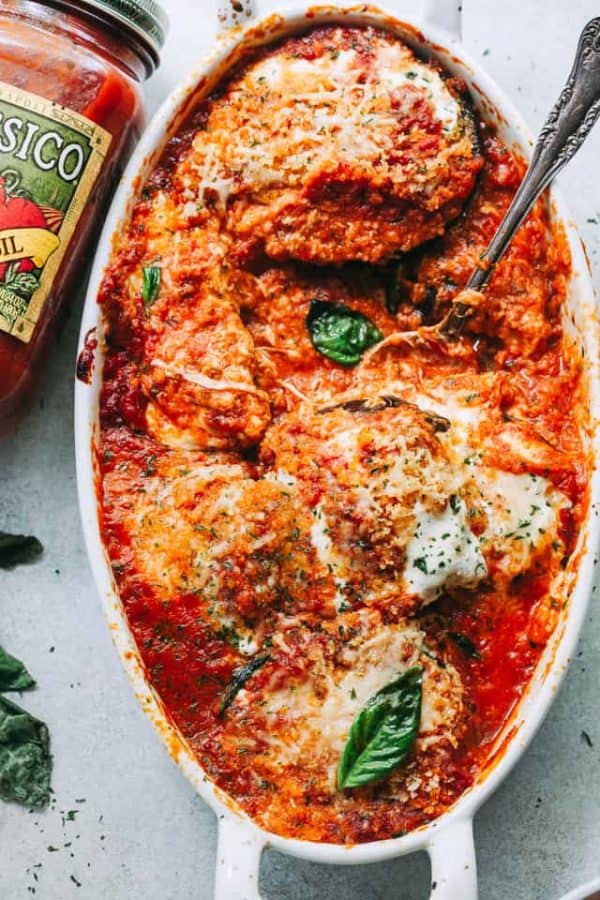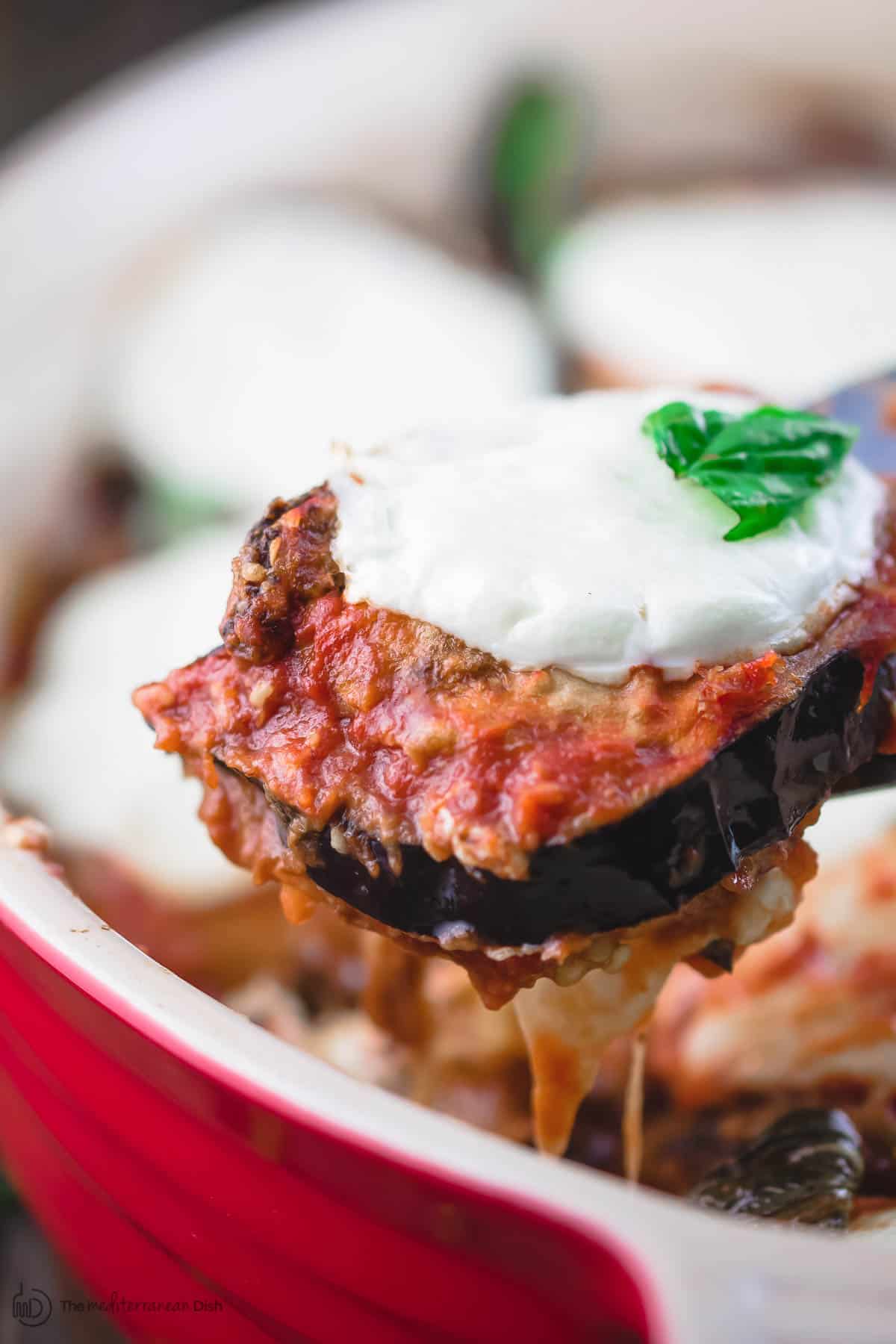Video tentang Eggplant Parmesan: A Deep Dive into a Classic Italian-American Comfort Food
Eggplant Parmesan: A Deep Dive into a Classic Italian-American Comfort Food

Eggplant Parmesan, or Melanzane alla Parmigiana in Italian, is more than just a dish; it’s a culinary experience, a testament to the transformative power of simple ingredients, and a beloved staple of Italian-American cuisine. This seemingly straightforward recipe, featuring layers of fried eggplant, rich tomato sauce, creamy mozzarella, and fragrant Parmesan cheese, boasts a history as complex and satisfying as its flavor profile. While its exact origins remain debated, its enduring popularity speaks volumes about its ability to capture hearts and palates across generations.
This article will delve deep into the world of Eggplant Parmesan, exploring its history, variations, the secrets to achieving the perfect texture and flavor, and offering tips and tricks to elevate your own culinary creation.
A History Steeped in Tradition (and a Little Mystery):
Pinpointing the precise origins of Eggplant Parmesan is a challenge. While eggplant has been cultivated in the Mediterranean region for centuries, its prominent role in Italian cooking didn’t fully emerge until the late 19th and early 20th centuries. Some culinary historians suggest its rise in popularity coincided with the increased availability and affordability of tomatoes, a crucial component of the dish.
The story of Eggplant Parmesan is inextricably linked to Italian immigration to the United States. It’s believed that the dish, as we know it today, evolved in the kitchens of Italian-American communities. They adapted traditional Italian preparations, incorporating readily available ingredients and adjusting techniques to suit their new environment. The generous layering of cheese, a hallmark of the American version, distinguishes it from its Italian counterparts, which often feature a more restrained approach to dairy.
While the definitive "inventor" of Eggplant Parmesan remains unknown, its evolution reflects the beautiful interplay between cultural exchange and culinary adaptation. It’s a dish that embodies the spirit of resourceful cooking, transforming a humble vegetable into a culinary masterpiece.
The Essential Ingredients: A Symphony of Flavors:
The beauty of Eggplant Parmesan lies in the simplicity and quality of its ingredients. Each component plays a vital role in creating the harmonious blend of flavors and textures that define this classic dish.

Eggplant: The star of the show, the eggplant should be firm, glossy, and free of blemishes. Japanese eggplants are often preferred for their less spongy texture and milder flavor. However, any variety will work, provided it’s properly prepared.
-
Tomato Sauce: A robust and flavorful tomato sauce is paramount. Many cooks prefer a homemade sauce, allowing for greater control over the flavor profile. However, a high-quality store-bought sauce can also yield excellent results. The sauce should be slightly acidic, with a balance of sweetness and savory notes.
-
Mozzarella Cheese: The creamy, melting texture of mozzarella is essential. Fresh mozzarella is ideal, but low-moisture part-skim mozzarella shreds are a convenient alternative. The cheese provides a rich, creamy counterpoint to the other ingredients.
-
Parmesan Cheese: Parmesan cheese adds a sharp, salty, and umami-rich dimension to the dish. Use a high-quality grated Parmesan, avoiding pre-shredded varieties which often contain cellulose.

-
Breadcrumbs: The breadcrumbs provide a crispy crust for the eggplant slices. Panko breadcrumbs are a popular choice for their light and airy texture. However, regular breadcrumbs can also be used.
-
Eggs: The eggs act as a binder, helping the breadcrumbs adhere to the eggplant slices.
-
Garlic: Garlic adds a pungent aroma and flavor that enhances the overall taste of the dish.
-
Basil: Fresh basil provides a bright, herbaceous note that complements the richness of the other ingredients. It’s best added towards the end of cooking to preserve its vibrant flavor.
-
Olive Oil: Olive oil is used for frying the eggplant slices, contributing to the dish’s overall richness and flavor.

Mastering the Technique: From Frying to Baking:
The success of Eggplant Parmesan hinges on proper technique. Here’s a step-by-step guide to ensure a perfect dish:
-
Preparing the Eggplant: Slice the eggplant into 1/4-inch thick rounds. Salt the slices generously and let them sit for at least 30 minutes to draw out excess moisture. This step is crucial for preventing soggy eggplant. Rinse and pat the slices dry before proceeding.
-
Breading and Frying: Dip each eggplant slice in beaten eggs, then dredge in breadcrumbs. Fry the slices in batches in hot olive oil until golden brown and crispy. Avoid overcrowding the pan, as this will lower the oil temperature and result in soggy eggplant.
-
Assembling the Casserole: Layer the fried eggplant slices in a baking dish, alternating with layers of tomato sauce, mozzarella cheese, and grated Parmesan cheese. Begin and end with a layer of sauce.
-
Baking: Bake the casserole in a preheated oven until the cheese is melted, bubbly, and golden brown. This typically takes around 20-30 minutes.
-
Resting: Allow the casserole to rest for a few minutes before slicing and serving. This allows the cheese to set and prevents a messy presentation.
Variations and Creative Twists:
While the classic Eggplant Parmesan recipe is a masterpiece in its simplicity, countless variations exist, reflecting the adaptability of this beloved dish. Some popular variations include:
-
Adding Meat: Ground meat, such as beef or sausage, can be added to the tomato sauce for a heartier dish.
-
Using Different Cheeses: Experiment with other cheeses, such as ricotta, provolone, or fontina, in addition to or in place of mozzarella.
-
Spice it Up: Add a pinch of red pepper flakes to the tomato sauce for a touch of heat.
-
Vegetarian Options: Enhance the vegetarian nature of the dish by adding roasted vegetables like zucchini or bell peppers.
-
Baked, not Fried: For a healthier option, bake the eggplant slices instead of frying them. This will result in a less crispy, but still delicious, outcome.
Tips and Tricks for Eggplant Parmesan Perfection:
-
Don’t skip the salting: Salting the eggplant is crucial for removing excess moisture and preventing a soggy dish.
-
Use hot oil: Ensure the oil is hot enough before frying the eggplant slices. This will help create a crispy crust.
-
Don’t overcrowd the pan: Fry the eggplant slices in batches to avoid lowering the oil temperature.
-
Use high-quality ingredients: The quality of your ingredients will directly impact the flavor of your dish.
-
Let it rest: Allow the casserole to rest before slicing and serving. This will prevent a messy presentation and allow the cheese to set.
Serving Suggestions:
Eggplant Parmesan is a satisfying dish that can be enjoyed on its own. However, it pairs well with a variety of sides, including:
-
A simple green salad: A fresh salad cuts through the richness of the casserole.
-
Garlic bread: Garlic bread is a classic accompaniment to many Italian dishes.
-
Pasta: Serve the eggplant parmesan over a bed of pasta for a complete meal.
Eggplant Parmesan is more than just a recipe; it’s a culinary journey, a testament to the ingenuity of Italian-American cooks, and a timeless comfort food that continues to delight generations. By understanding its history, mastering the techniques, and experimenting with variations, you can create your own perfect version of this classic dish, ensuring its legacy continues for years to come.

Penutup
Therefore, we hope this article has provided valuable insights on Eggplant Parmesan: A Deep Dive into a Classic Italian-American Comfort Food. We hope you found this article informative and helpful. See you in our next article!

